2015 MERCEDES-BENZ SLS AMG GT ROADSTER stop start
[x] Cancel search: stop startPage 122 of 290
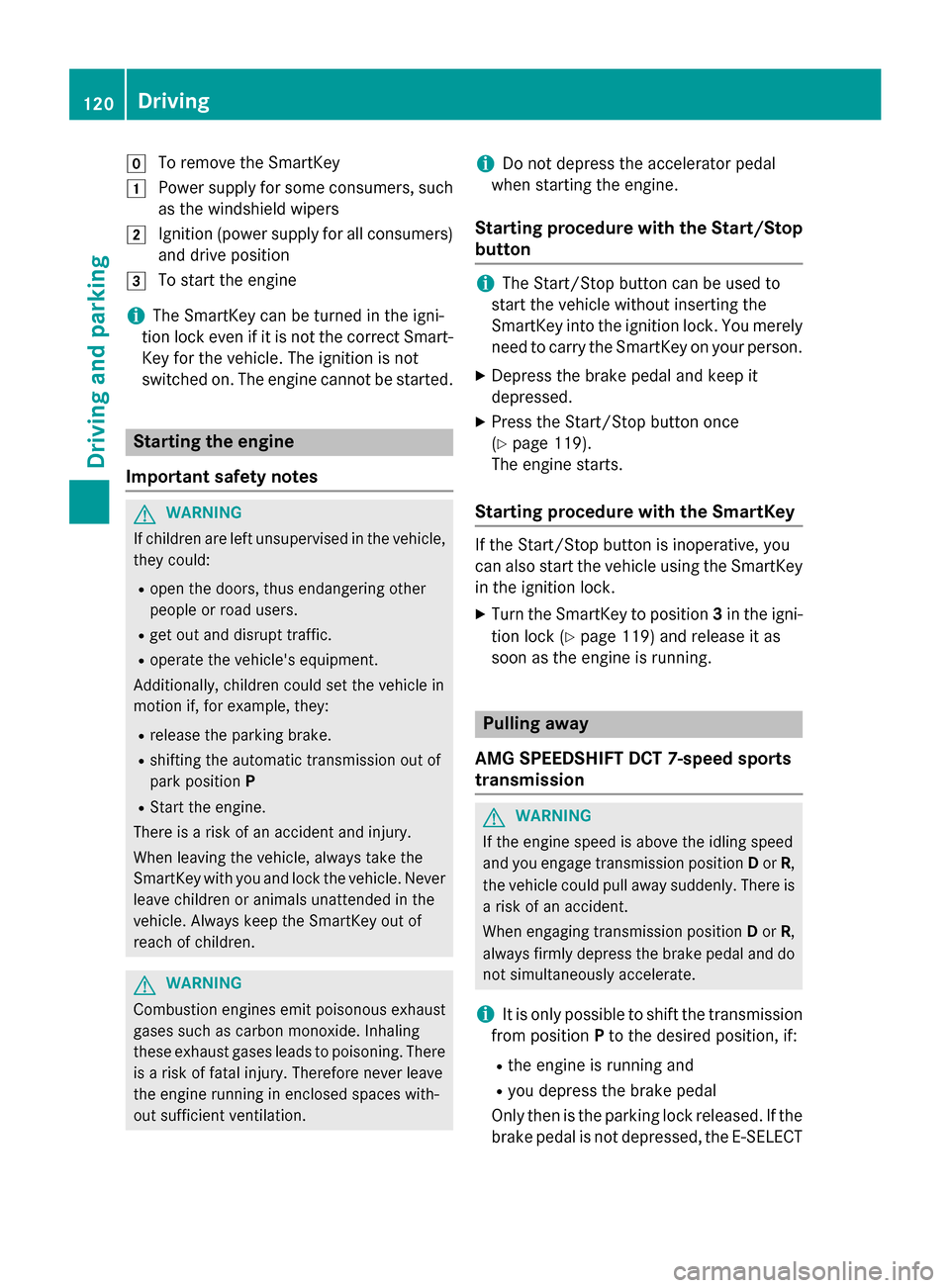
005A
To remove the SmartKey
0047 Power supply for some consumers, such
as the windshield wipers
0048 Ignition (power supply for all consumers)
and drive position
0049 To start the engine
i The SmartKey can be turned in the igni-
tion lock even if it is not the correc tSmart-
Key for the vehicle. The ignition is not
switched on. The engine cannot be started. Starting the engine
Important safety notes G
WARNING
If children are left unsupervised in the vehicle, they could:
R open the doors, thus endangerin gother
people or road users.
R get out and disrupt traffic.
R operate the vehicle's equipment.
Additionally, children could set the vehicle in
motion if, for example, they:
R release the parking brake.
R shiftin gthe automatic transmission out of
park position P
R Start the engine.
There is arisk of an accident and injury.
When leaving the vehicle, alway stake the
SmartKey with you and lock the vehicle. Never
leave children or animals unattended in the
vehicle. Always keep the SmartKey out of
reach of children. G
WARNING
Combustion engines emit poisonous exhaust
gases such as carbon monoxide. Inhaling
these exhaust gases leads to poisoning. There is ar isk of fatal injury. Therefore never leave
the engine runnin ginenclosed spaces with-
out sufficient ventilation. i
Do not depress the accelerator pedal
when starting the engine.
Starting procedure with the Start/Stop
button i
The Start/Stop button can be used to
start the vehicle without inserting the
SmartKey into the ignition lock. You merely
need to carry the SmartKey on your person.
X Depress the brake pedal and keep it
depressed.
X Press the Start/Stop button once
(Y page 119).
The engine starts.
Starting procedure with the SmartKey If the Start/Stop button is inoperative, you
can also start the vehicle using the SmartKey
in the ignition lock.
X Turn the SmartKey to position 3in the igni-
tion lock (Y page 119) and release it as
soon as the engine is running. Pulling away
AMG SPEEDSHIF TDCT 7-speed sports
transmission G
WARNING
If the engine speed is above the idling speed
and you engage transmission position Dor R,
the vehicle could pull away suddenly. There is ar isk of an accident.
When engaging transmission position Dor R,
alway sfirmly depress the brake pedal and do
not simultaneously accelerate.
i It is only possible to shift the transmission
from position Pto the desired position, if:
R the engine is runnin gand
R you depress the brake pedal
Only then is the parking lock released. If the
brake pedal is not depressed, the E-SELECT 120
DrivingDriving and parking
Page 124 of 290
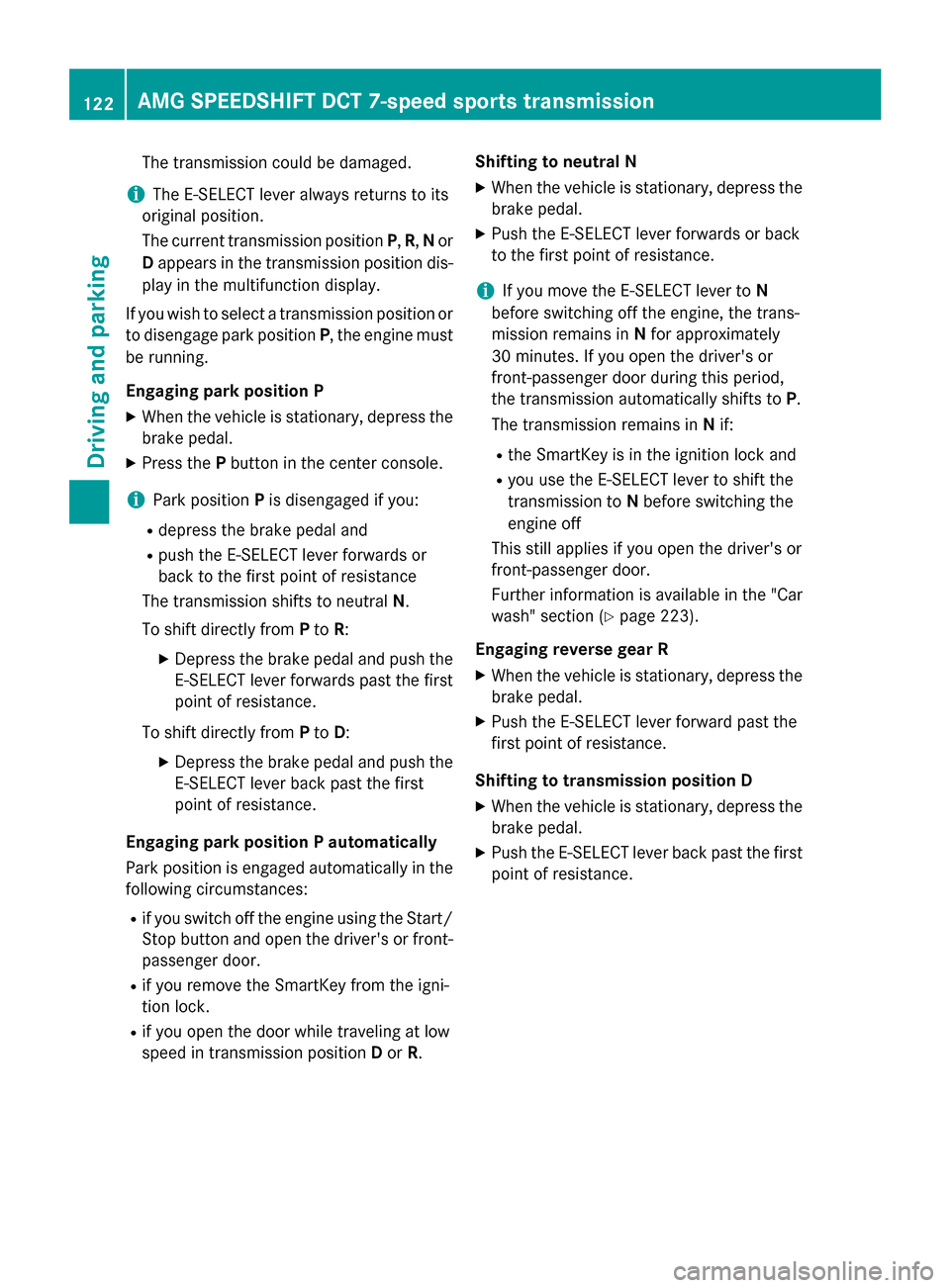
The transmission could be damaged.
i The E-SELECT lever alway
sreturn stoits
original position.
The curren ttransmission position P,R, Nor
D appears in the transmission position dis-
play in the multifunction display.
If you wish to select atransmission position or
to disengage park position P,the engine must
be running.
Engaging parkp osition P
X When the vehicle is stationary, depress the
brake pedal.
X Press the Pbutton in the center console.
i Park position Pis disengaged if you:
R depress the brake pedal and
R push the E-SELECT lever forwards or
back to the first point of resistance
The transmission shifts to neutral N.
To shift directly from Pto R:
X Depress the brake pedal and push the
E-SELECT lever forwards past the first
point of resistance.
To shift directly from Pto D:
X Depress the brake pedal and push the
E-SELECT lever back past the first
point of resistance.
Engaging parkp ositionPautomatically
Park position is engaged automatically in the following circumstances:
R if you switch off the engine using the Start/
Stop button and open the driver's or front- passenger door.
R if you remove the SmartKey from the igni-
tion lock.
R if you open the door while traveling at low
speed in transmission position Dor R. Shifting to neutral N
X When the vehicle is stationary, depress the
brake pedal.
X Push the E-SELECT lever forwards or back
to the first point of resistance.
i If you move the E-SELECT lever to
N
before switchin goff the engine, the trans-
mission remains in Nfor approximately
30 minutes. If you open the driver's or
front-passenger door during this period,
the transmission automatically shifts to P.
The transmission remains in Nif:
R the SmartKey is in the ignition lock and
R you use the E ‑SELECT lever to shift the
transmission to Nbefore switchin gthe
engine off
This still applies if you open the driver's or
front-passenger door.
Further information is available in the "Car
wash" section (Y page 223).
Engaging reverse gear R X When the vehicle is stationary, depress the
brake pedal.
X Push the E-SELECT lever forward past the
first point of resistance.
Shifting to transmission position D
X When the vehicle is stationary, depress the
brake pedal.
X Push the E-SELECT lever back past the first
point of resistance. 122
AMG SPEEDSHIFT DCT 7-speed sportst
ransmissionDriving and parking
Page 133 of 290
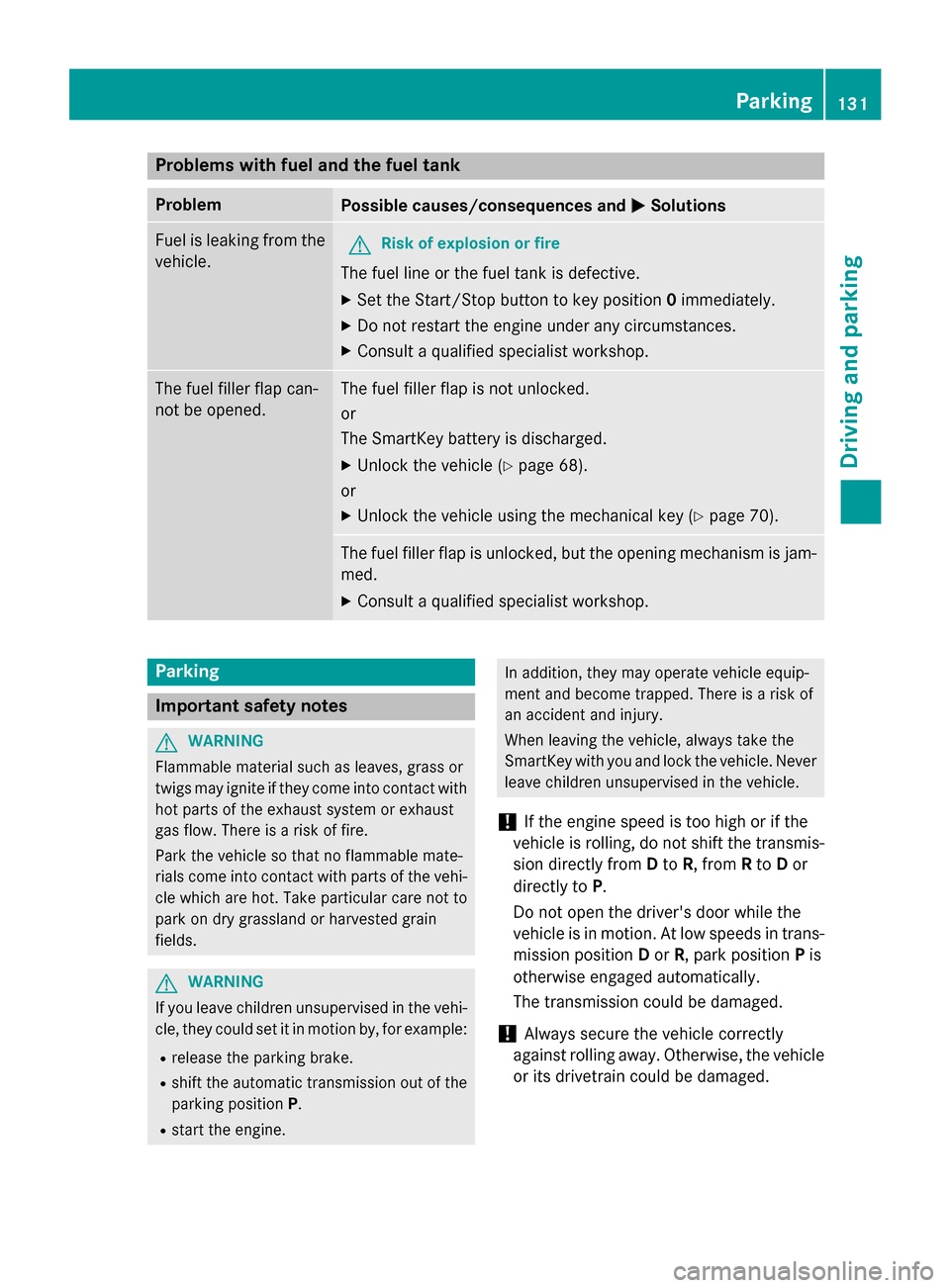
Problems with fuel and the fuel tank
Problem
Possible causes/consequences and
0050
0050Solutions Fuel is leaking from the
vehicle. G
Risk of explosion or fire
The fuel line or the fuel tank is defective.
X Set the Start/Stop button to key position 0immediately.
X Do not restart the engine under any circumstances.
X Consult aqualified specialist workshop. The fuel filler flap can-
not be opened. The fuel filler flap is not unlocked.
or
The SmartKey battery is discharged.
X Unlock the vehicle (Y page 68).
or X Unlock the vehicle using the mechanical key (Y page 70).The fuel filler flap is unlocked, but the opening mechanism is jam-
med.
X Consult aqualified specialist workshop. Parking
Important safety notes
G
WARNING
Flammable material such as leaves, grass or
twigs may ignite if they come into contact with hot parts of the exhaust system or exhaust
gas flow. There is arisk of fire.
Park the vehicle so that no flammable mate-
rials come into contact with parts of the vehi- cle which are hot. Take particular care not to
park on dry grassland or harvested grain
fields. G
WARNING
If you leave children unsupervised in the vehi- cle, they could set it in motion by, for example:
R release the parking brake.
R shift the automatic transmission out of the
parking position P.
R start the engine. In addition, they may operate vehicle equip-
ment and become trapped. There is
arisk of
an accident and injury.
When leaving the vehicle, always take the
SmartKey with you and lock the vehicle. Never leave children unsupervised in the vehicle.
! If the engine speed is too high or if the
vehicle is rolling, do not shift the transmis-
sion directly from Dto R,f rom Rto Dor
directly to P.
Do not open the driver's door while the
vehicle is in motion. At low speeds in trans-
mission position Dor R,p ark position Pis
otherwise engaged automatically.
The transmission could be damaged.
! Always secure the vehicle correctly
against rolling away.O therwise, the vehicle
or its drivetrain could be damaged. Parking
131Driving and parking Z
Page 134 of 290
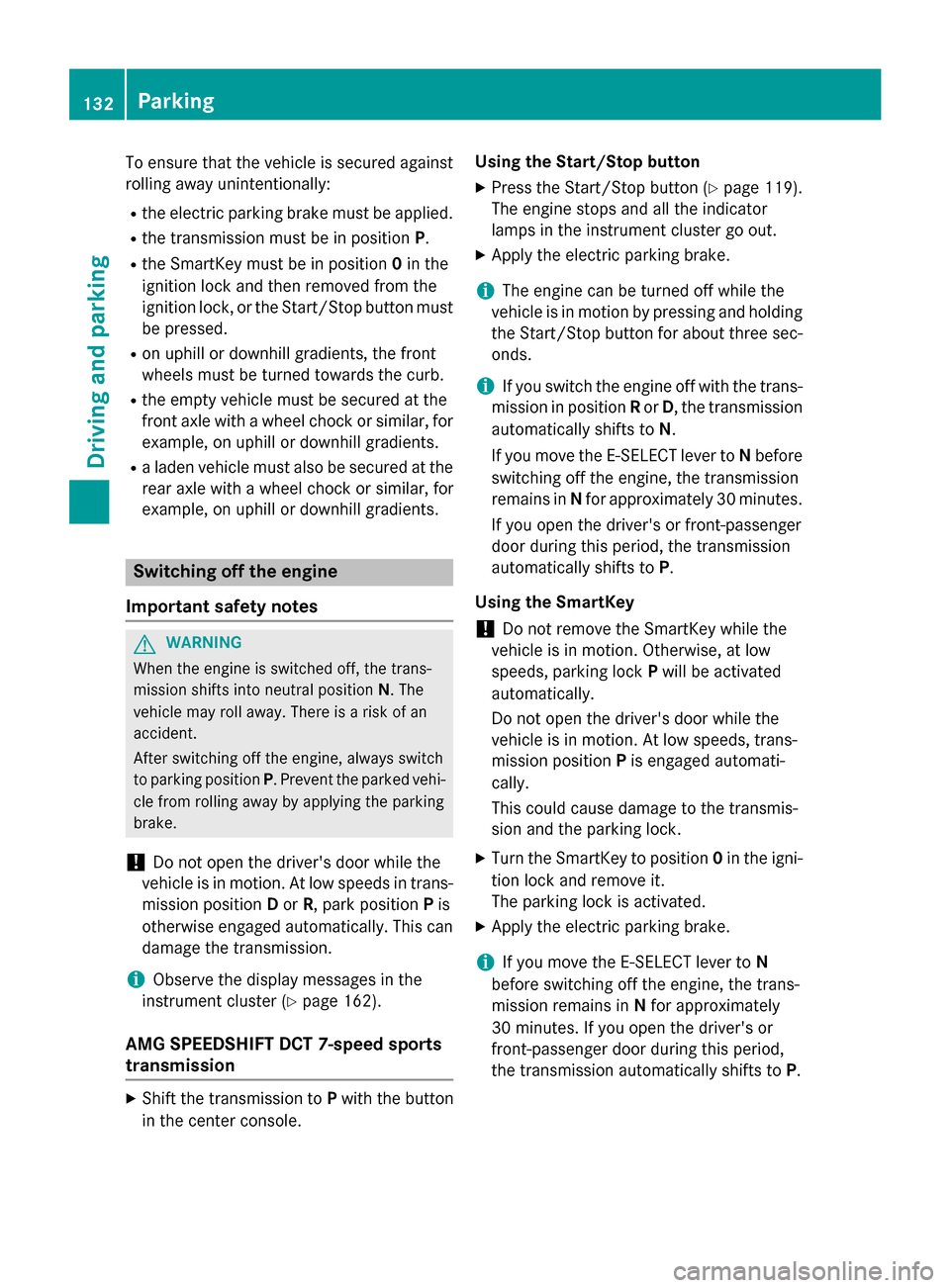
To ensure that the vehicle is secured against
rolling away unintentionally:
R the electric parking brake must be applied.
R the transmission must be in position P.
R the SmartKey must be in position 0in the
ignition lock and then removed from the
ignition lock, or the Start/Stop button must be pressed.
R on uphill or downhill gradients, the front
wheels must be turned towards the curb.
R the empty vehicle must be secured at the
fronta xle with awheel chock or similar, for
example, on uphill or downhill gradients.
R aladen vehicle must also be secured at the
rear axle with awheel chock or similar, for
example, on uphill or downhill gradients. Switching off the engine
Important safety notes G
WARNING
When the engine is switched off, the trans-
mission shifts into neutral position N.The
vehicle may roll away.T here isarisk of an
accident.
After switchin goff the engine, alway sswitch
to parking position P.Prevent the parked vehi-
cle from rolling away by applying the parking
brake.
! Do not open the driver's door while the
vehicle is in motion .Atlow speeds in trans-
mission position Dor R,p ark position Pis
otherwise engaged automatically. This can damage the transmission.
i Observe the display messages in the
instrument cluster (Y page 162).
AMG SPEEDSHIF TDCT 7-speed sports
transmission X
Shift the transmission to Pwith the button
in the center console. Using the Start/Stop button
X Press the Start/Stop button (Y page 119).
The engine stops and all the indicator
lamps in the instrument cluster go out.
X Apply the electric parking brake.
i The engine can be turned off while the
vehicle is in motion by pressing and holding the Start/Stop button for about three sec-
onds.
i If you switch the engine off with the trans-
mission in position Ror D,t he transmission
automatically shifts to N.
If you move the E-SELECT lever to Nbefore
switchin goff the engine, the transmission
remains in Nfor approximately 30 minutes.
If you open the driver's or front-passenger
door during this period, the transmission
automatically shifts to P.
Using the SmartKey ! Do not remove the SmartKey while the
vehicle is in motion .Otherwise, at low
speeds, parking lock Pwill be activated
automatically.
Do not open the driver's door while the
vehicle is in motion .Atlow speeds, trans-
mission position Pis engaged automati-
cally.
This could cause damage to the transmis-
sion and the parking lock.
X Turn the SmartKey to position 0in the igni-
tion lock and remove it.
The parking lock is activated.
X Apply the electric parking brake.
i If you move the E-SELECT lever to
N
before switchin goff the engine, the trans-
mission remains in Nfor approximately
30 minutes. If you open the driver's or
front-passenger door during this period,
the transmission automatically shifts to P.132
ParkingDriving and parking
Page 135 of 290
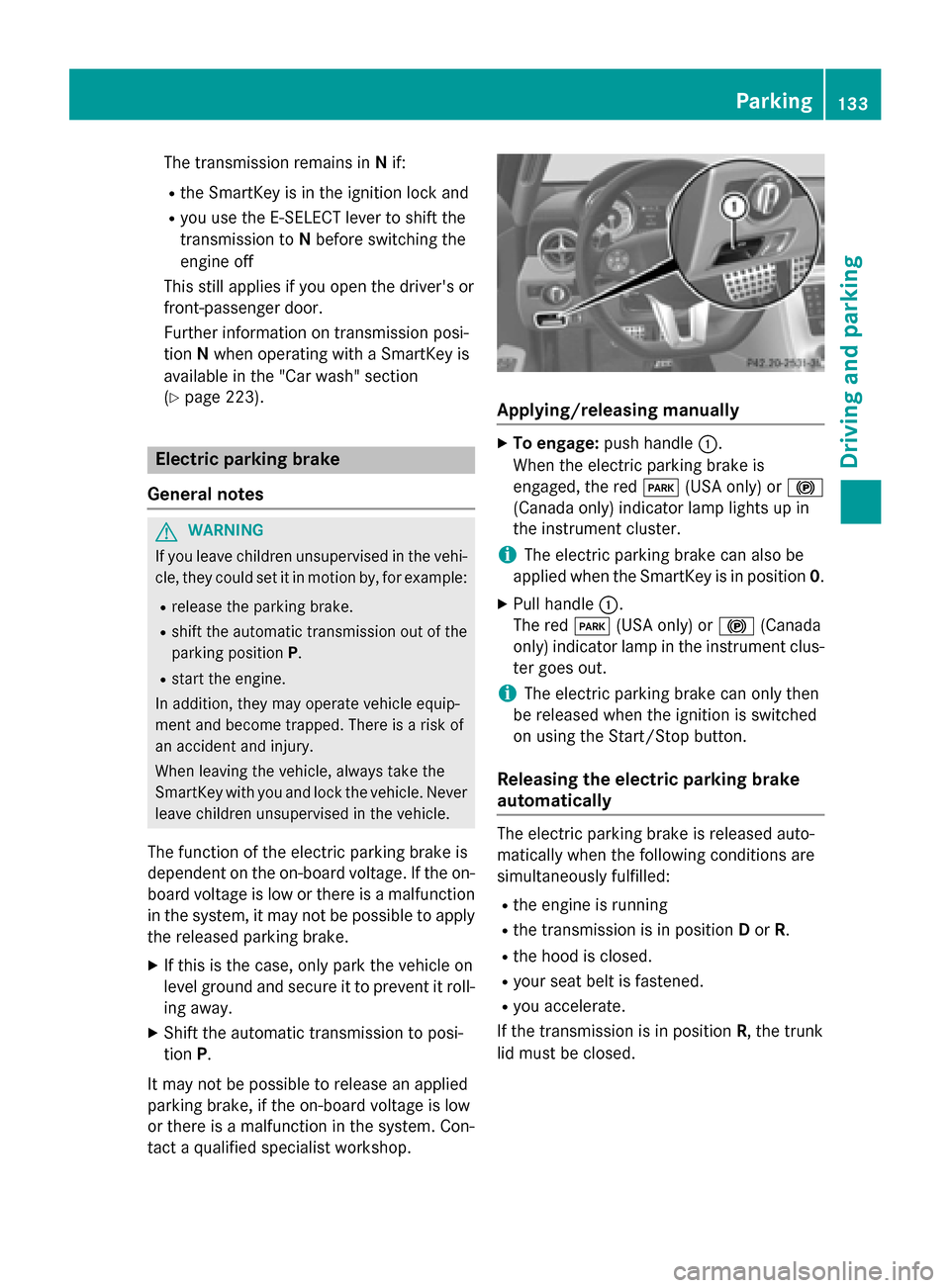
The transmission remains in
Nif:
R the SmartKey is in the ignition lock and
R you use the E ‑SELECT lever to shift the
transmission to Nbefore switchin gthe
engine off
This still applies if you open the driver's or
front-passenger door.
Further information on transmission posi-
tion Nwhen operating with aSmartKey is
available in the "Car wash" section
(Y page 223). Electric parking brake
General notes G
WARNING
If you leave children unsupervised in the vehi- cle, they could set it in motion by, for example:
R release the parking brake.
R shift the automatic transmission out of the
parking position P.
R start the engine.
In addition, they may operate vehicle equip-
ment and become trapped. There is arisk of
an accident and injury.
When leaving the vehicle, alway stake the
SmartKey with you and lock the vehicle. Never
leave children unsupervised in the vehicle.
The function of the electric parking brake is
dependent on the on-board voltage. If the on-
board voltage is low or there is amalfunction
in the system, it may not be possible to apply
the released parking brake.
X If this is the case, only park the vehicle on
level ground and secure it to prevent it roll- ing away.
X Shift the automatic transmission to posi-
tion P.
It may not be possible to release an applied
parking brake, if the on-board voltage is low
or there is amalfunction in the system. Con-
tact aqualified specialist workshop. Applying/releasing manually
X
To engage: push handle 0043.
When the electric parking brake is
engaged, the red 0049(USA only) or 0024
(Canada only) indicator lamp lights up in
the instrument cluster.
i The electric parking brake can also be
applied when the SmartKey is in position 0.
X Pull handle 0043.
The red 0049(USA only) or 0024(Canada
only) indicator lamp in the instrument clus- ter goes out.
i The electric parking brake can only then
be released when the ignition is switched
on using the Start/Stop button.
Releasing the electric parking brake
automatically The electric parking brake is released auto-
matically when the following conditions are
simultaneously fulfilled:
R the engine is running
R the transmission is in position Dor R.
R the hood is closed.
R your seat belt is fastened.
R you accelerate.
If the transmission is in position R,the trunk
lid must be closed. Parking
133Driving and parking Z
Page 137 of 290
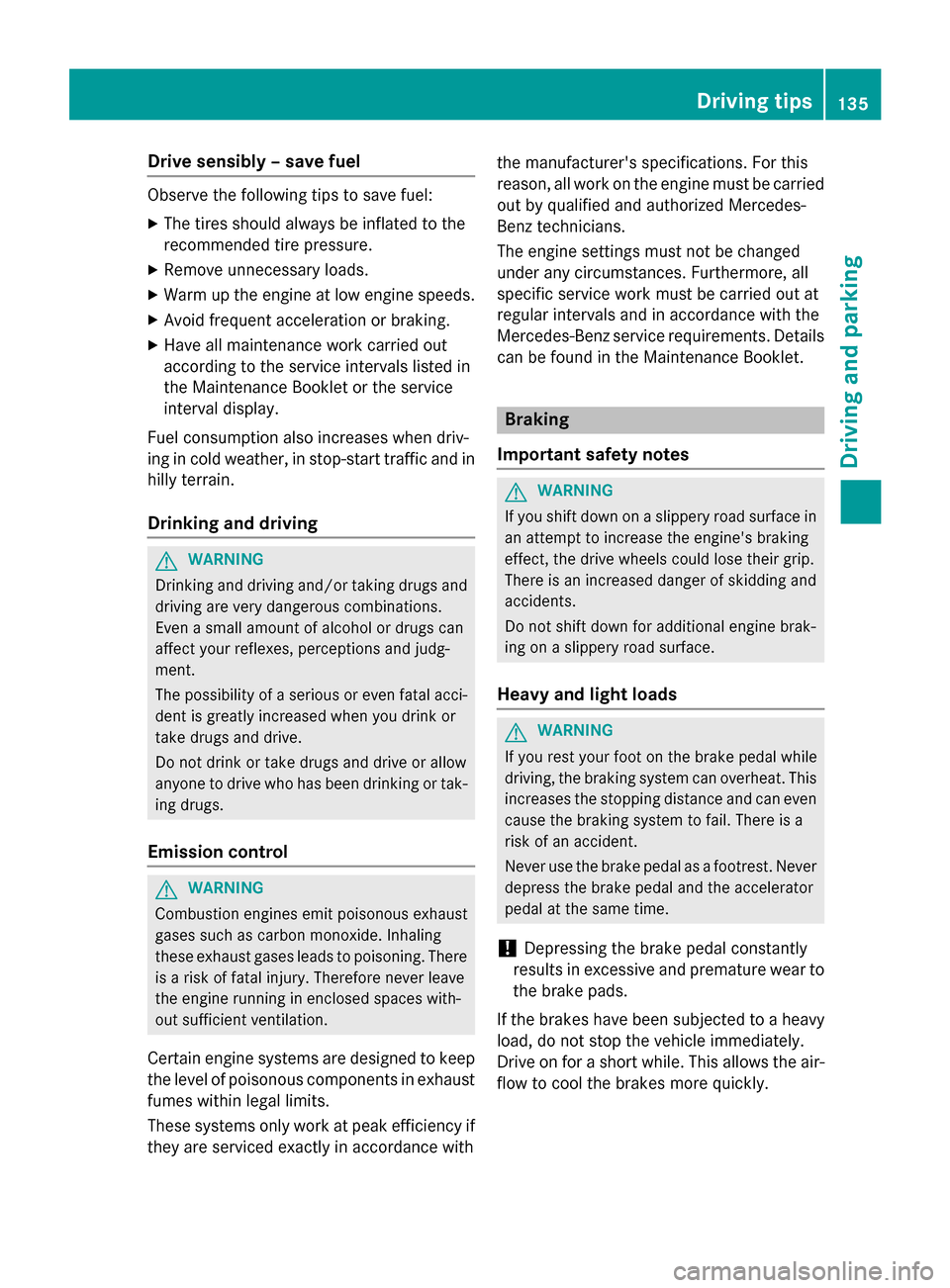
Drive sensibly
–savef uel Observ
ethe following tips to sav efuel:
X The tires should always be inflated to the
recommended tire pressure.
X Remov eunnecessary loads.
X War mupt heengin eatlow engin espeeds.
X Avoid frequent acceleration or braking.
X Hav eall maintenance wor kcarrie dout
accordin gtotheservic einterva ls listed in
th eM aintenance Booklet or th eservice
interval display.
Fue lconsu mption also increase swhen driv-
in ginc oldw eather ,instop-start traffic and in
hill yterra in.
Drinking an ddriving G
WARNING
Drinking and drivin gand/o rtaking drugs and
drivin gare ver ydangerous combinations.
Even asma ll amount of alcoho lordrugs can
affec tyour reflexes, perception sand judg-
ment.
The possibilit yofas erious or eve nfatal acci-
den tisg reatly increase dwhen you drink or
take drugs and drive.
Do no tdrink or take drugs and drive or allow
anyon etodrive who has bee ndrinkin gortak-
in gd rugs.
Emission control G
WARNING
Combustion engines emi tpoisonous exhaust
gases suc hascarbon monoxide. Inhaling
these exhaus tgases lead stopoisoning. There
is ar iskoff atal injury. Therefor enever leave
th ee nginer unning in enclose dspaces with-
out sufficien tventilation.
Certain engin esystems are designed to keep
th el evel of poisonous component sinexhaust
fumes within lega llimits.
These systems only wor katpeak efficiency if
they are serviced exactly in accordance with th
em anufacturer's specifications. Fo rthis
reason ,all wor kont heengin emustbec arried
out by qualified and authorized Mercedes-
Benz technicians.
The engin esetting smustn otbe changed
under any circumstances. Furthermore, all
specific servic eworkm ustbec arriedout at
regular intervals and in accordance wit hthe
Mercedes-Ben zservic erequirements .Detai ls
can be found in th eMaintenance Booklet. Braking
Important safet ynotes G
WARNING
If you shift down on aslipper yroads urfac ein
an attempt to increase th eengine's braking
effect ,the drive wheels could los etheir grip.
There is an increase ddanger of skidding and
accidents.
Do no tshift down fo radditional engin ebrak-
in gonas lipperyroads urface.
Heavy an dligh tloads G
WARNING
If you res tyour foot on th ebrake peda lwhile
driving, th ebraking system can overheat .This
increase sthe stoppin gdistanc eand can even
cause th ebraking system to fail .There is a
ris kofana ccident.
Never use th ebrake peda lasafootrest. Never
depress th ebrake peda land th eaccelerator
peda latthesam etime.
! Depressing th
ebrake peda lconstantly
result sinexcessive and premature wear to
th eb rake pads.
If th ebrake shaveb een subjecte dtoa heavy
load ,don otstop th evehicle immediately.
Drive on fo rashort while. Thi sallow sthe air-
flo wt ocoolthe brake smoreq uickly. Driving tips
135Driving andpark ing Z
Page 138 of 290
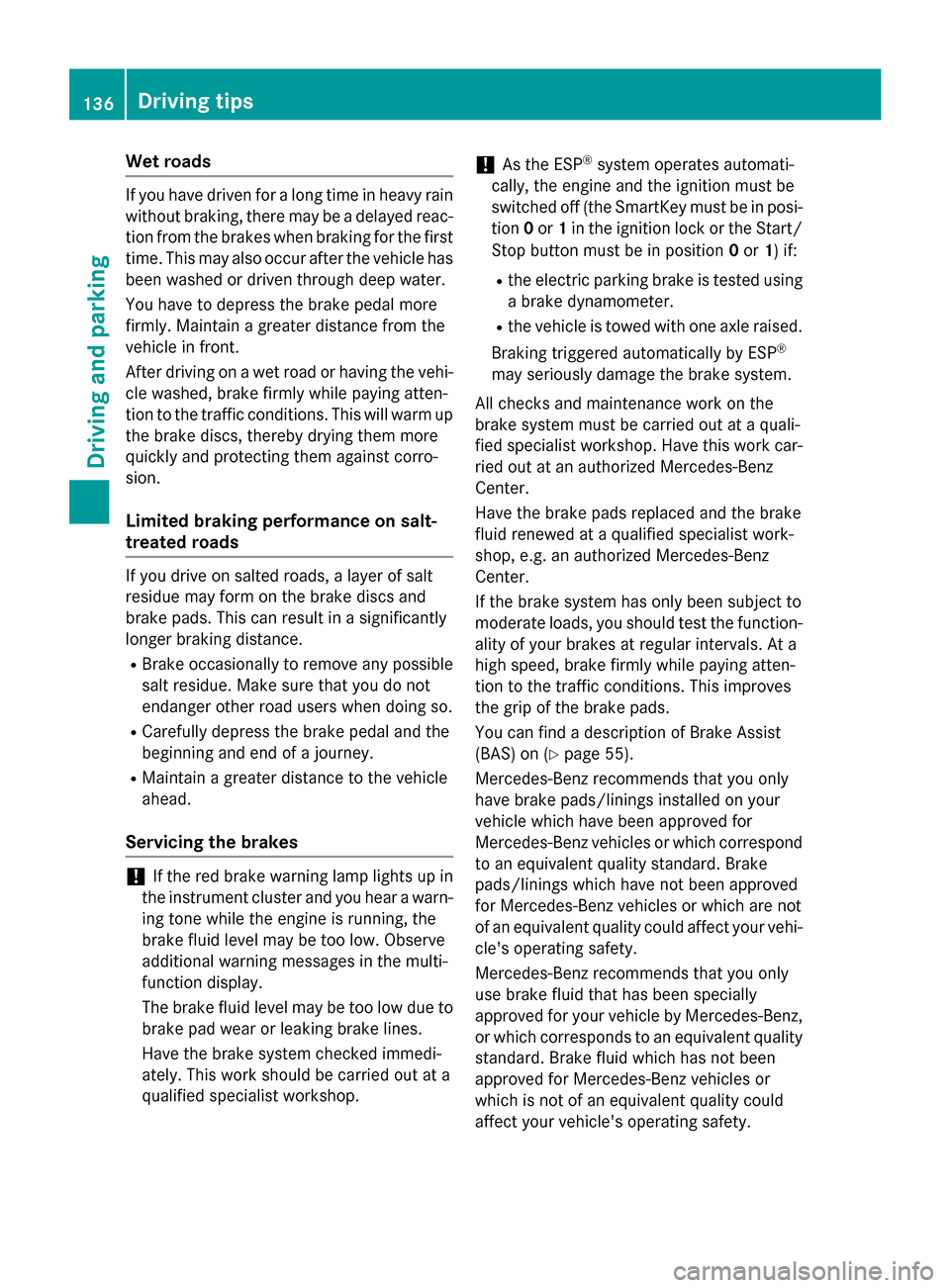
Wet roads
If you have drive
nfor along time in heavy rain
without braking, there may be adelayed reac-
tion from the brakes whe nbraking for the first
time. This may also occur after the vehicl ehas
been washed or drive nthroug hdeep water.
You have to depress the brake pedal more
firmly .Maintain agreater distance from the
vehicl einfront.
After driving on awet road or having the vehi-
cle washed ,brake firmly while paying atten-
tion to the traffic conditions. This wil lwarmup
the brake discs, thereby drying them more
quickly and protecting them against corro-
sion.
Limited braking performance on salt-
treated roads If you drive on salted roads,
alayer of salt
residue may form on the brake discs and
brake pads. This can result in asignificantly
longe rbraking distance.
R Brake occasionally to remove any possible
sal tresidue. Make sure that you do not
endange rother road users whe ndoing so.
R Carefully depress the brake pedal and the
beginning and end of ajourney.
R Maintain agreater distance to the vehicle
ahead.
Servicing the brakes !
If the red brake warning lamp lights up in
the instrument cluster and you hea rawarn-
ing tone while the engine is running, the
brake fluid leve lmay be too low .Observe
additiona lwarning messages in the multi-
function display.
The brake fluid leve lmay be too low due to
brake pad wea rorleaking brake lines.
Have the brake syste mchecked immedi-
ately. This work should be carrie dout at a
qualified specialist workshop. !
As the ESP ®
syste moperates automati-
cally, the engine and the ignition must be
switched off (the SmartKey must be in posi-
tion 0or 1in the ignition lock or the Start/
Stop button must be in position 0or 1)i f:
R the electric parking brake is tested using
ab rake dynamometer.
R the vehicl eistowed with one axle raised.
Braking triggered automatically by ESP ®
may seriousl ydamage the brake system.
All checks and maintenance work on the
brake syste mmust be carrie dout at aquali-
fied specialist workshop. Have this work car- ried out at an authorized Mercedes-Benz
Center.
Have the brake pad sreplaced and the brake
fluid renewe dataqualified specialist work-
shop, e.g. an authorized Mercedes-Benz
Center.
If the brake syste mhas only been subject to
moderate loads, you should test the function- ality of you rbrakes at regulari ntervals. At a
high speed, brake firmly while paying atten-
tion to the traffic conditions. This improves
the grip of the brake pads.
You can find adescription of Brake Assist
(BAS) on (Y page55).
Mercedes-Benz recommends that you only
have brake pads/linings installed on your
vehicl ewhich have been approved for
Mercedes-Benz vehicles or which correspond to an equivalent quality standard. Brake
pads/linings which have not been approved
for Mercedes-Benz vehicles or which are not
of an equivalent quality coul daffect you rvehi-
cle's operating safety.
Mercedes-Benz recommends that you only
use brake fluid that has been specially
approved for you rvehicl ebyM ercedes-Benz,
or which corresponds to an equivalent quality standard. Brake fluid which has not been
approved for Mercedes-Benz vehicles or
which is not of an equivalent quality could
affect you rvehicle's operating safety. 136
Driving tipsDriving and parking
Page 149 of 290
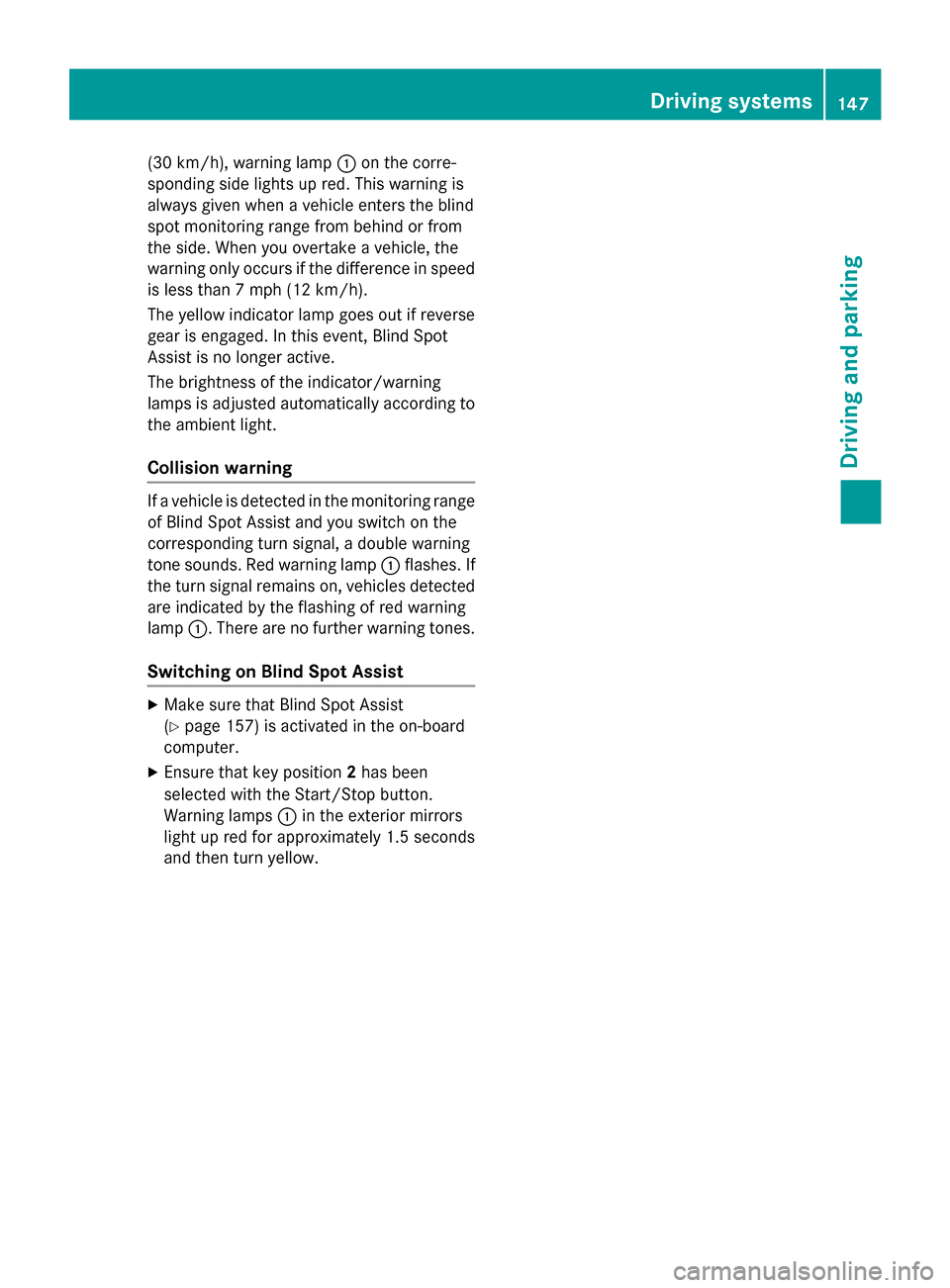
(30 km/h), warnin
glamp 0043on the corre-
sponding side lights up red. This warnin gis
always given when avehicle enters the blind
spot monitoring range from behind or from
the side. When you overtake avehicle, the
warnin gonly occurs if the differenc einspeed
is less than 7mph (12 km/h).
The yellow indicator lamp goes out if reverse gear is engaged. In this event, Blin dSpot
Assist is no longer active.
The brightness of the indicator/warning
lamps is adjusted automatically according to
the ambient light.
Collision warning If
av ehicle is detected in the monitoring range
of Blin dSpot Assist and you switc honthe
corresponding turn signal, adouble warning
ton esounds .Red warnin glamp 0043flashes. If
the turn signal remain son, vehicles detected
are indicated by the flashin gofred warning
lamp 0043.There are no further warnin gtones.
Switching on Blind Spot Assist X
Make sure that Blin dSpot Assist
(Y page 157) is activated in the on-board
computer.
X Ensure that key position 2has been
selected with the Start/Stop button.
Warnin glamps 0043in the exterior mirrors
light up red for approximately 1.5 seconds
and then turn yellow. Driving systems
147Driving and parking Z